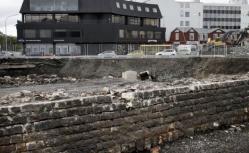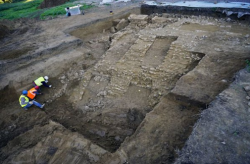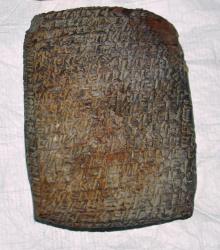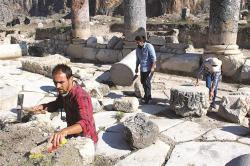INSTITUT SUPERIEUR D'ANTHROPOLOGIE
INSTITUTE OF ANTHROPOLOGY
ONLINE COURSES / COURS A DISTANCE
WINTER TERM : JANUARY 2016
REGISTER NOW
ISLANDE –  Reykjavík - Early this summer constructors digging for the foundation of a new development in downtown Reykjavík came upon the fully preserved stretches of the old harbour. This archaeological find came as a surprise, as nobody had expected the old harbour quay to have been preserved fully intact. The structures discovered included the foundations of old warehouses, as well as large parts of two different harbour quays: One built in 1900 and a second constructed in 1928.
Reykjavík - Early this summer constructors digging for the foundation of a new development in downtown Reykjavík came upon the fully preserved stretches of the old harbour. This archaeological find came as a surprise, as nobody had expected the old harbour quay to have been preserved fully intact. The structures discovered included the foundations of old warehouses, as well as large parts of two different harbour quays: One built in 1900 and a second constructed in 1928.
http://icelandmag.visir.is/article/war-over-old-harbour-comes-end-old-harbour-quay-will-be-preserved-inside-a-parking-garage?
ITALIE –  Volterra - Archaeologists in Italy believe that they may have found the remains of a Roman colosseum situated in Tuscany. The base of the oval structure was discovered in Volterra, located in the centre of Tuscany, and could date back to the first century AD – at the height of the Roman Empire. Initial estimates suggest that the amphitheatre's base would have measured 262 by 196 feet, although further excavations are required to draw a sufficient conclusion on the actual size. Although large, it is still smaller than the largest colosseum discovered in the Roman Empire's capital that had a capacity of 50,000. Elena Sorge, an archaeologist of the Tuscan Superintendency, told Discovery News: "This amphitheatre was quite large. Our survey dig revealed three orders of seats that could accommodate about 10,000 people. They were entertained by gladiators' fights and wild beast baiting. The finding sheds a new light on the history of Volterra, which is most famous for its Etruscan legacy. It shows that during the Emperor Augustus's rule, it was an important Roman centre." The archaeologists said that the building was constructed with stone and decorated in a local Volterran stone known as panchino, which was used to build the town's walls. Using ground penetrating radar from the University of Genoa, the team discovered that the amphitheatre had a depth of up to 32ft.nTo date, the team have unearthed a large sculpted stone and the entrance to the cryptoporticus. Sorge added: "It's puzzling that no historical account records the existence of such an imposing amphitheatre. Possibly, it was abandoned at a certain time and gradually covered by vegetation."
Volterra - Archaeologists in Italy believe that they may have found the remains of a Roman colosseum situated in Tuscany. The base of the oval structure was discovered in Volterra, located in the centre of Tuscany, and could date back to the first century AD – at the height of the Roman Empire. Initial estimates suggest that the amphitheatre's base would have measured 262 by 196 feet, although further excavations are required to draw a sufficient conclusion on the actual size. Although large, it is still smaller than the largest colosseum discovered in the Roman Empire's capital that had a capacity of 50,000. Elena Sorge, an archaeologist of the Tuscan Superintendency, told Discovery News: "This amphitheatre was quite large. Our survey dig revealed three orders of seats that could accommodate about 10,000 people. They were entertained by gladiators' fights and wild beast baiting. The finding sheds a new light on the history of Volterra, which is most famous for its Etruscan legacy. It shows that during the Emperor Augustus's rule, it was an important Roman centre." The archaeologists said that the building was constructed with stone and decorated in a local Volterran stone known as panchino, which was used to build the town's walls. Using ground penetrating radar from the University of Genoa, the team discovered that the amphitheatre had a depth of up to 32ft.nTo date, the team have unearthed a large sculpted stone and the entrance to the cryptoporticus. Sorge added: "It's puzzling that no historical account records the existence of such an imposing amphitheatre. Possibly, it was abandoned at a certain time and gradually covered by vegetation."
http://www.ibtimes.co.uk/ancient-roman-gladiator-amphitheatre-discovered-tuscany-1528408?
TURQUIE –  Kültepe - The inclusion of 5,000-year-old Kültepe tablets in the UNESCO Memory of the World Register in October has attracted the interest of international academics and historians to the ancient city. The kiln tablets, considered the earliest written documentation of life in Anatolia, were unearthed during archaeological excavations on the Kültepe-Kaniş-Karum mound in the Central Anatolian province of Kayseri. Professor Fikri Kulakoğlu said the Kültepe Tablets were registered by UNESCO because they were the biggest cuneiform tablets in the history of mankind and that they were special in terms of their number and content. “The Kültepe tablets are completely owned by the private sector, private individuals. The content of the tablets is 99 percent commercial. They are not official state documents; they are the archive of free traders. In this term, they are the earliest private sector documents. Therefore, the tablets feature the feelings of traders at that time. Thanks to these tablets, we can get information about the socio-cultural structure of people who lived 5,000 years ago. It’s not just shopping; we can see what they went through in their daily life. It is not possible to get such information in the state archives,” said Kulakoğlu.
Kültepe - The inclusion of 5,000-year-old Kültepe tablets in the UNESCO Memory of the World Register in October has attracted the interest of international academics and historians to the ancient city. The kiln tablets, considered the earliest written documentation of life in Anatolia, were unearthed during archaeological excavations on the Kültepe-Kaniş-Karum mound in the Central Anatolian province of Kayseri. Professor Fikri Kulakoğlu said the Kültepe Tablets were registered by UNESCO because they were the biggest cuneiform tablets in the history of mankind and that they were special in terms of their number and content. “The Kültepe tablets are completely owned by the private sector, private individuals. The content of the tablets is 99 percent commercial. They are not official state documents; they are the archive of free traders. In this term, they are the earliest private sector documents. Therefore, the tablets feature the feelings of traders at that time. Thanks to these tablets, we can get information about the socio-cultural structure of people who lived 5,000 years ago. It’s not just shopping; we can see what they went through in their daily life. It is not possible to get such information in the state archives,” said Kulakoğlu.
http://www.hurriyetdailynews.com/kultepe-tablets-open-kayseri-to-the-world-.aspx?PageID=238&NID=91029&NewsCatID=375
TURQUIE –  Anavarza - Excavations in the ancient city of Anavarza, located in the southern province of Adana, have unearthed new city walls from the 8th and 9th centuries. Head of the excavations, Çukurova University Archaeology Department Assistant Professor Fatih Gülşen said works had been continuing with a team of 40 people and the new walls were discovered during cleaning work around the excavation field. “The nearly 4.5 kilometer-long city walls date back to the 8th and 9th centuries, when Arabs were dominant in the region. There are two gates on the 30-meter-wide walls. They are called the western gates. The main street is reached through the gates,” Gülşen said.
Anavarza - Excavations in the ancient city of Anavarza, located in the southern province of Adana, have unearthed new city walls from the 8th and 9th centuries. Head of the excavations, Çukurova University Archaeology Department Assistant Professor Fatih Gülşen said works had been continuing with a team of 40 people and the new walls were discovered during cleaning work around the excavation field. “The nearly 4.5 kilometer-long city walls date back to the 8th and 9th centuries, when Arabs were dominant in the region. There are two gates on the 30-meter-wide walls. They are called the western gates. The main street is reached through the gates,” Gülşen said.
http://www.hurriyetdailynews.com/new-city-walls-found-in-ancient-anavarza.aspx?pageID=238&nid=91037&NewsCatID=375
CHINE - Nanchang - Archaeologists in China have unearthed two 2,000-year-old smoke-absorbing bronze lamps in the country’s east Jiangxi Province, an important discovery which suggests Chinese lamp-makers were capable of making designs to reduce air pollution millennia before it made headlines worldwide. The lamps that can “swallow” smoke were excavated at a noted Western Han Dynasty (206 BC—24 AD) Haihunhou cemetery. The lamps are in the shape of a goose catching a fish in its mouth with light attached to the fish. Smoke emitted during the burning of wax can enter the bird’s body via an intake on the fish, travel through its neck and be dissolved by water stored in its hollow belly, Xin Lixiang, who leads the excavation team, told state-run Xinhua news agency on Thursday. The Han Dynasty was the heyday for Chinese bronze lamps, but such smoke-absorbing designs were probably afforded only by high nobles. The two lamps were found in September in the tomb of “Haihunhou” (Marquis of Haihun).
http://www.thehindu.com/news/international/ancient-smokeabsorbing-lamps-found-in-china/article7869526.ece?